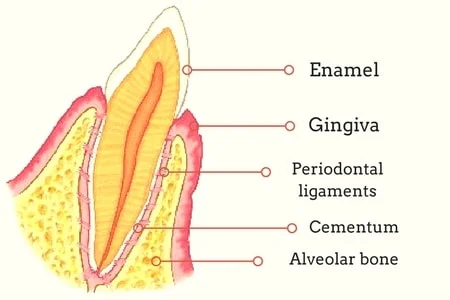Tooth anatomy.
Periodontium or tooth's supporting structure
The periodontium (also known as marginal periodontium) is the supporting structure of a tooth, helping to attach the tooth to surrounding tissues and to allow sensations of touch and pressure.
The word comes from the Greek terms peri, meaning "around" and odons, meaning "tooth." Literally taken, it means that which is "around the tooth".
The periodontium consists of four principal components:
- gingiva or the gum
- cementum, covering the root of the tooth
- alveolar bone
- periodontal ligament

Each of these components is distinct in its location, tissue architecture, biochemical and chemical composition. They have their own distinct functions and are capable of adaptation during the life of the structure.
1. Gingiva or the gum
Gingiva is a soft tissue that overlays the jaw bone and surrounds the teeth providing a seal around them. Gingival tissue is tightly bound to the underlying bone creating an effective barrier (when healthy) for periodontal insults to deeper tissues.
Healthy gingiva is usually coral pink but may contain melanin pigmentation. Healthy gingiva has a smooth "arcuate" appearance around each tooth, a firm texture that is resistant to movement and no reaction (such as bleeding) to normal disturbance such as brushing or periodontal probing.

healthy gingiva
Gum infection, called gingivitis, occurs because of microbes in plaque placed on the tooth if oral hygiene is poor.
Changes in color, particularly increased redness, together with edema or swelling and an increased tendency to bleed (for example during teeth brushing), suggest an inflammation due to the accumulation of bacterial plaque.
In a more advanced stage of infection, a gingival retraction may occur; this leaves part of the roots naked.

gingivitis caused by
the accumulation of bacterial plaque

gingival recession
Inflammation of the gums is the first stage of the periodontal disease. An early treatment is indicated before the disease advances to a deeper tissue leading to a poorer prognosis.
2. Cementum
Cementum is a specialized calcified substance covering the root of a tooth. It is the part of the periodontium that attaches the teeth to the alveolar bone by anchoring the periodontal ligament.
Cementum is formed continuously throughout life because a new layer of cementum is deposited to keep the attachment intact as the superficial layer of cementum ages. It has a light yellow color and the highest fluoride content of all mineralized tissues.
3. Alveolar bone
The alveolar bone is the bone of the jaw that contains the tooth sockets (also known as dental alveoli or alveolar process) on bones that hold teeth.
The alveolar process contains a region of compact bone (called the lamina dura) which is attached to the cementum of the roots by the periodontal ligaments.
Like any other bone in the human body, alveolar bone is modified throughout life; under the effect of various external factors, it may suffer processes of bone resorption or bone formation.
4. Periodontal ligament
The periodontal ligament is a specialized connective tissue that attaches the cementum of a tooth to the alveolar bone. They are a network of elastic fibres that help support the tooth inside the alveolar bone socket.



The functions of the periodontal ligaments include attachment of the tooth to the bone, support for the tooth, formation, and resorption of bone during tooth movement, sensation, and eruption.
When pressure is exerted on a tooth, such as during chewing or biting, the tooth moves slightly in its socket and puts tension on the periodontal ligaments. This is called tooth physiologic mobility.
The periodontium exists for the purpose of supporting teeth during their function; a constant state of balance always exists between the periodontal structures and the external forces.
Most of the times, periodontal diseases are caused by bacteria from the dental plaqueDental plaque is a biofilm, usually a pale yellow, that develops naturally on the teeth formed by colonizing bacteria trying to attach themselves to the tooth's smooth surface. which is adherent to tooth surfaces.
In case of bacterial infections, the first barrier is the gum. In the absence of treatment, the infection progresses to the periodontal ligaments and the alveolar bone involving the progressive loss of the alveolar bone around the teeth which can lead to the loosening and subsequent loss of teeth.



Periodontics is the dental specialty that relates specifically to the care, maintenance, and treatment of the periodontal tissues.



